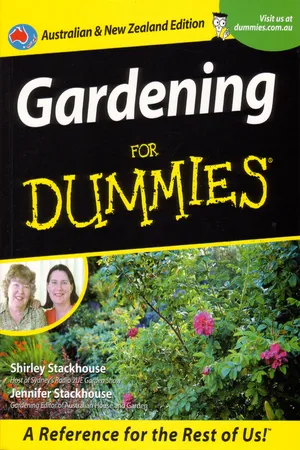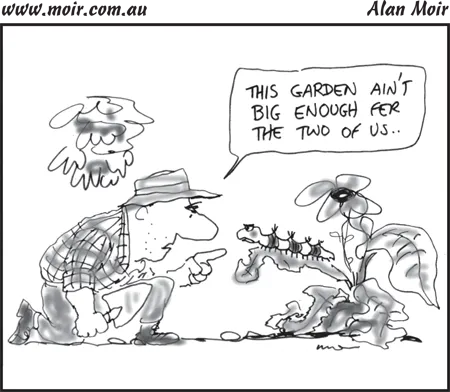
eBook - ePub
Gardening For Dummies
Shirley Stackhouse, Jennifer Stackhouse
This is a test
Share book
- English
- ePUB (mobile friendly)
- Available on iOS & Android
eBook - ePub
Gardening For Dummies
Shirley Stackhouse, Jennifer Stackhouse
Book details
Book preview
Table of contents
Citations
About This Book
Brimming with advice, resources and suggested planting choices, this friendly guide shows you step by step how to create the garden of your dreams. From basic cultivation to garden design, this book is just what you need to start playing in the dirt? even if you?ve never picked up a garden trowel in your life.
Frequently asked questions
How do I cancel my subscription?
Can/how do I download books?
At the moment all of our mobile-responsive ePub books are available to download via the app. Most of our PDFs are also available to download and we're working on making the final remaining ones downloadable now. Learn more here.
What is the difference between the pricing plans?
Both plans give you full access to the library and all of Perlego’s features. The only differences are the price and subscription period: With the annual plan you’ll save around 30% compared to 12 months on the monthly plan.
What is Perlego?
We are an online textbook subscription service, where you can get access to an entire online library for less than the price of a single book per month. With over 1 million books across 1000+ topics, we’ve got you covered! Learn more here.
Do you support text-to-speech?
Look out for the read-aloud symbol on your next book to see if you can listen to it. The read-aloud tool reads text aloud for you, highlighting the text as it is being read. You can pause it, speed it up and slow it down. Learn more here.
Is Gardening For Dummies an online PDF/ePUB?
Yes, you can access Gardening For Dummies by Shirley Stackhouse, Jennifer Stackhouse in PDF and/or ePUB format, as well as other popular books in Biological Sciences & Horticulture. We have over one million books available in our catalogue for you to explore.
Information

Part I
Your Patch of Dirt
In this part...
Gardening is about improving your surroundings and making a beautiful and comfortable environment in which to relax and play. Garden-making is not only a practical and down-to-earth pursuit, it’s also a way of expressing yourself and being creative.
In Part I, we show you how to discover your garden’s potential by working out how much sun and shade it gets and the direction it faces; we give you an understanding of soil and drainage; and, importantly, we finish with advice on how to deal with some of the climate extremes that nature throws at us from time to time.
Chapter 1
Analysing Your Garden
In This Chapter



Whether you’ve got an established garden or just a patch of bare earth waiting to take shape, you need to ‘read’ your garden and assess what you’ve got before you can begin to plan and plant. Take the time to get acquainted with your particular piece of ground. Discover your garden’s sunniest and shadiest parts. Feel the soil and look at where the water naturally goes. All these factors affect the success and wellbeing of the plants you grow and the garden you make.
In this chapter, we show you how to start building your garden’s dossier — its personal profile, if you like. You need to be observant, so have your mental notebook ready (oh, and a compass may help, too!).
Which Way is North?
The direction your garden faces is known as its aspect. Your garden’s aspect is important because it can determine whether you’ve got a sunny garden or a shady one. To find what aspect you have, just figure out which direction is north (easier said than done on a dull day!).
Knowing which way is north is absolutely crucial if you want to grow plants — not so you can find your way to the nursery without getting lost but because north’s the direction from which the sun shines, and plants need sun to grow. To a certain extent, the kind of home you have defines your scope for gardening. If your house is free-standing, you have more options: some parts of the garden are certain to be sunnier than others, depending on which side of the house they are. However, terrace houses, villas and units often only have a back garden or a balcony, with a single aspect. If this sounds like you, we have loads of creative solutions! Here we describe the four main aspects (as well as the aspect you have when it’s half and half):

The canny gardener will check out the aspect before buying a new property. If you add sunny north facing aspect to your selection criteria, you can be sure of having a sunny garden where you can grow all your favourite plants, herbs and vegies without too much trouble.
To grow shade-loving plants in a garden with a sunny aspect, you’ll need to create some shade (for example, with a pergola) or find a more sheltered spot to the east or south. If there are trees or other tall structures to the north, your garden will get filtered sunlight or shadows as the sun moves across the sky.






